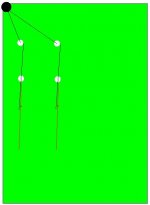av84fun said:
Colin, with respect, you seem to blow hot and cold. Above you seem to be genuinely interested in this method but in a nearby post, you stated point blank that it does not and cannot work without a required repositioning of the bridge hand which, if true, would destroy the "systematic" nature of the method.
If you wish to approach this topic in a truly "scientific" manner then you should withhold comments that it cannot work until you understand the recommended dynamics of the system.
Just IMHO. And where do you live these days? Last I knew you were in the Orient but headed back to OZ?
You STILL have one of the best break shot demonstrations I've ever seen.
Try to explain THAT in text only!!!
(-:
Jim,
I don't think I'm hot & cold. I think you and Dave are friends. When I disagree with one or both of you, or anyone else for that matter, doesn't infer that I don't like them or disagree with everything they say. Though I know criticizing a point can offend some. I try to put my criticisms in the form of questions to clarify sometimes but that makes for some pretty boring reading. Some readers like to know where you stand from time to time, so stating my opinion is part of that. And a large part is trying to learn things I haven't previously known about these systems.
Back to the other questions now:
I thought it was pretty well established through various discussions and by geometrical proof that for the system to find the aim line, the bridge hand must be offset by various amounts from the CTE line.
In fact, if anyone can make an overhead video with see through grid, showing the bridge, cue ball and OB, using the same bridge length at the same distance (offset) from the CTE line, with CB and OB in the same positions and make shots of about 20 degrees and 40 degrees then I will send them $200.
It seems to me, that this is what you are claiming you can do?
I won't hold back on my comments because I believe I know a lot about these types of methodologies. I've done extensive diagramming and calculations on them and also done a lot of real practice with them over the past few years. I have my theories on why certain aspects work. I also never stop hearing new explanations about how it works and various methods of adjustments, but rarely do two people ever have the exact same interpretation.
Yes, I haven't talked to Hal. I figure if he could explain it then one of the many here who have called him could explain what he told them in terms of exactly how they make the pivot adjustment in a systematic way that makes sense.
If someone asks about Joe Tucker's Aiming system or CIT or BHE then people who have read articles or watched videos or used the systems don't have too much problem explaining it.
I actually think Dave is explaining it well. He sees the line to the center of the CB. He doesn't do this according to any mechanical system to adjust. He just knows how to adjust it seems.
Attempts to describe the adjustment (and there has to be an adjustment while we live in this dimension, else we'd only hit the CB along the CTE line), have never made sense. Some are offered but never in detail.
Maybe Stan's system has a different approach, but I think we should stick with purely Houlian systems and their explanations for now. They work for players, the question is how the adjustments are made, and that is why there is so much focus on any mechanical explanations for the adjustments, because many who have looked into, and even used the system don't believe there is one.
I must be really boring some readers now.
The next question:
I moved back to Australia from China about 18 months ago. Didn't have my US table up for most of that time so was entertaining myself with a bit of snooker and english style pool. Made the semi final in the Aussie 9-ball Nationals last year, not long after I got here. Just getting back into the game recently. Would love to qualify for the world champs, preferably 10-ball, some day but don't want to be a full time player. Just happy to learn US pool a little better and to stroke and aim well enough to test various systems / methods and to produce the odd instructional video. Some people actually appreciate my contrarian paralytic analysis.:shocked:
Maybe after all this head banging we'll work out what we actually agree on re: CTE / Houlian systems.
Colin

